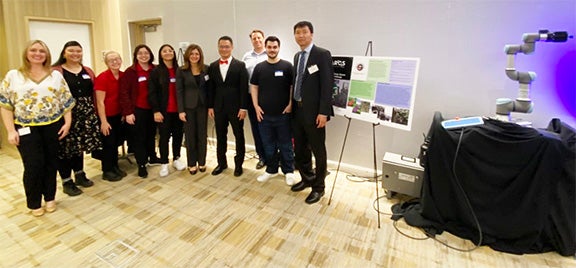This story is re-posted from CSUN Today. Read the story in CSUN Today.
 After completing the second round of the NASA Deep Space Food Challenge – a competition conceived to create novel and game-changing food technologies or systems for long-duration space missions – an interdisciplinary team of California State University Northridge faculty, staff and students are working to transform their space-based farming system to benefit people on Earth.
After completing the second round of the NASA Deep Space Food Challenge – a competition conceived to create novel and game-changing food technologies or systems for long-duration space missions – an interdisciplinary team of California State University Northridge faculty, staff and students are working to transform their space-based farming system to benefit people on Earth.
The CSUN team, Astro Cultivators, one of the 32 teams selected out of over 300 teams from 32 countries, had the opportunity to participate in phase 2 of the challenge, but was one of the few self-funded teams, thanks to the CSUN Matador Match program in tandem with generous donations from CSUN alumnae Susan Ettinger.
After receiving an honorable mention at the conclusion of the second round, the Astro Cultivators began to build and develop a prototype of their conceived food system, altering it to be functional on a terrestrial level. The project has evolved from an automated space-farming system to an AI-driven autonomous freight-farming system designed to operate in a repurposed shipping container.
“After seeing the project and discussing it with family and consumer sciences professor Annette Besnilian, the team leader, I know that a significant amount of experimentation, innovation and hard work led to the team’s success,” said Mechelle Best, dean of CSUN’s College of Health and Human Development. “The compilation of this team reflects collaboration across departments and educational institutions. It is a wonderful example of how the sky is indeed the limit when we work together.”
Team members include faculty, staff, and students from the Marilyn Magaram Center for Food Science, Nutrition and Dietetics in the College of Health and Human Development. Staff team members from the center included Registered Dietitian Nutritionist April Diederich, Food Science Coordinator Julie Miller, and Garden Coordinator Andreas George, led by Besnilian, executive director of the center and April Diederich, the center’s assistant director, and mechanical engineering professor Nhut Ho, the founding director of the NASA-sponsored Autonomy Research Center for STEAHM (ARCS) and assistant professor of manufacturing systems engineering Bingbing Li, an ARCS faculty member.
Current student members include manufacturing systems engineering graduate student Elliot Sadler, mechanical engineering student Jasmine Glover, computer engineering students Anthony Morales-Badajoz, Neville Elieh Janvisloo and Troy Israel, along with high school student research interns Larry Zhang from Agoura High and Andrew Wang from Portola High School in Irvine.
“The bulk of our research, as is the same with a lot of the projects at ARCS, is focused not only building innovative systems and assemblies with industry partners, but also on researching the things that those companies and large organizations would be interested in, such as the effects of the products,” said Sadler, a founding team member who is also serving as the project lead. “We’re not just thinking let’s build this because we can, we’re also thinking about the why of building this.”
The team’s system was originally designed to grow self-pollinating crops, decreasing the time space crews spend operating plant growth systems to near zero. The objective has now shifted toward addressing nutrition scarcity in geographical food deserts.
Their creation will do so by providing autonomous monitoring, real-time data reporting, environment management, automatic harvesting and automatic cleaning, all inside the environment of a freight car. After harvest, the crops would undergo further testing for food safety, antioxidant content and acceptability to ensure the produce grown meets basic health and safety needs.
“The terrestrial aspects of the innovation are almost more robust, exciting and ultimately beneficial to us, right here and now,” said Sadler. “We’ve attempted to make these models as cost efficient and self-sustaining as possible. If you scale that up, you can imagine all the possibilities that a company with a couple million to spare could do with a system like this in a place where there is no farmland for miles.”
This story is re-posted from CSUN Today. Read the story in CSUN Today.
Su 2023
Kaley Block, CSUN Today
